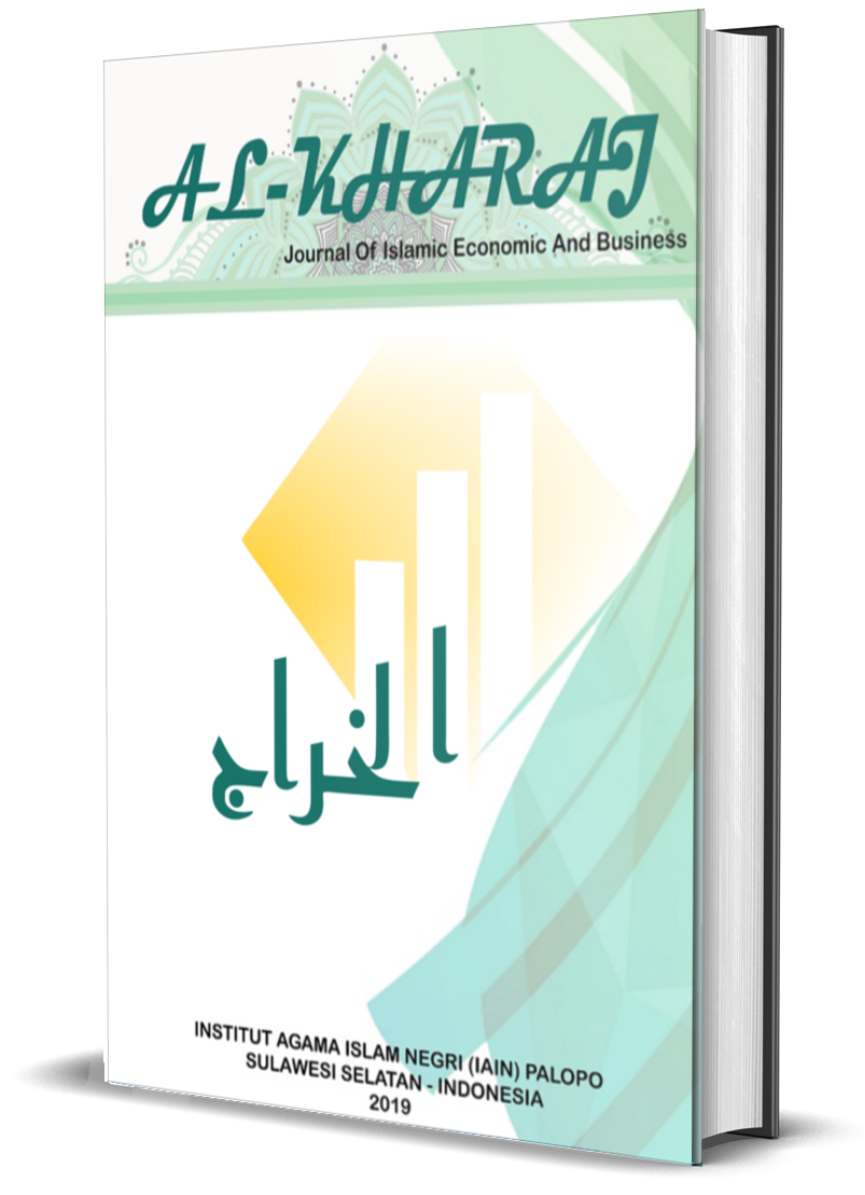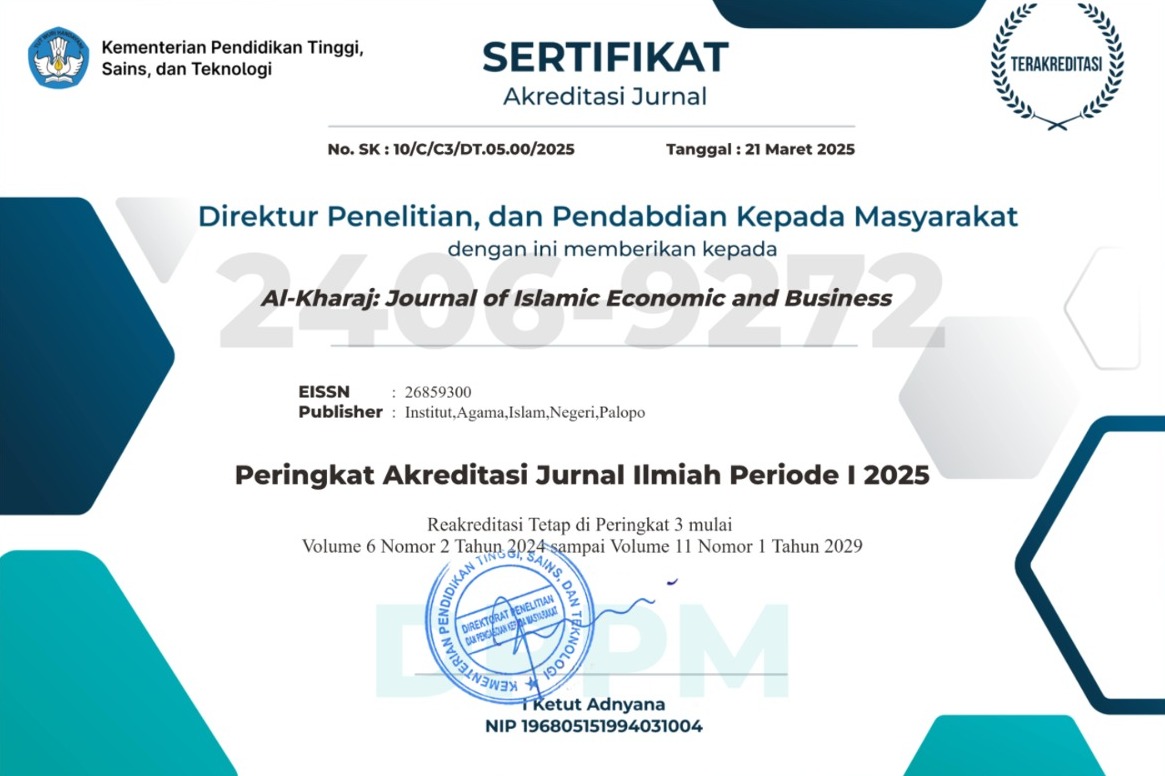Investment Risk Management Strategies in the Sharia Capital Market: Perspectives of Retail and Institutional Investors
DOI:
https://doi.org/10.24256/kharaj.v7i2.7569Keywords:
-Abstract
.
References
Abdullah, A. K. (2013). Risk sharing, transfer and management. ICR Journal, 4(2), 279–294.
Abdulrahman, Z., Ebrahimi, T., & Al-Najjar, B. (2024). Shariah-related disclosure: a literature review and directions for future research. International Journal of Disclosure and Governance, 21(4), 642–665.
Alshubiri, F., & Al Ani, M. K. (2023). Financing and returns of Shari’ah-compliant contracts and sustainable investing in the Islamic banking of Oman. Economic Change and Restructuring, 56(4), 2455–2491.
Anisa, S. N., & AF, M. S. F. (2024). The Impact of Islamic Financial Literacy on Gen Z’s Investment Decisions in The Islamic Capital Market. Islamic Capital Market, 2(2).
Asiyah, B. N., Nasir, M. R., & Ahsan, M. (2019). Islamic Prudential Banking Concept to Reduce Non Performing Financing. Jurnal Iqtishadia, 173–188.
Bawalle, A. A., Khan, M. S. R., & Kadoya, Y. (2025). Overconfidence, financial literacy, and panic selling: Evidence from Japan. PloS One, 20(3), e0315622.
Jaiyeoba, H. B., Abdullah, M. A., & Ibrahim, K. (2020). Institutional investors vs retail investors: Are psychological biases equally applicable to investor divides in Malaysia? International Journal of Bank Marketing, 38(3), 671–691.
Kamil, N. K., Bacha, O. I., & Masih, M. (2021). Is there a diversification “cost” of Shari’ah compliance? Empirical evidence from Malaysian equities. Economic Systems, 45(1), 100817.
Khandelwal, S., & Aljifri, K. (2021). Risk sharing vs risk shifting: a comparative study of Islamic banks. Journal of Islamic Accounting and Business Research, 12(8), 1105–1123.
Kusnawirawan, I., Syarkani, Y., Hernayati, H., & Waluyo, I. (2025). Safeguarding Investor Rights: OJK’s Regulatory Framework Including Management and Challenges in Indonesia’s Capital Market. Jurnal Multidisiplin Indonesia, 4(3), 193–201.
Miller, M. B. (2018). Quantitative financial risk management. John Wiley & Sons.
Muhamad Sori, Z. B., & Perwiragama, S. A. (2025). Enhancing Transparency and Governance: Implementing Sharia Compliance Framework in Indonesia’s IPF Sector.
Najeeb, S. F., & Vejzagic, M. (2013). Development, growth and challenges of Islamic capital markets: Comparative insights from the Malaysian, Indonesian, United Arab Emirates and Brunei markets. Journal of Emerging Economies and Islamic Research, 1(3), 100–137.
Sabirzyanov, R., & Hashim, M. H. (2015). Takaful (Islamic insurance), risk management and Maqasid Al-Shari ‘ah. İslam Ekonomisi ve Finansı Dergisi/Journal of Islamic Economics and Finance (JIEF).
Saranj, A., & Zolfaghari, M. (2025). Trading behavior-stock market volatility nexus among institutional and individual investors. Financial Innovation, 11(1), 98.
Seho, M., Alaaabed, A., & Masih, M. (2016). Risk-sharing financing of Islamic banks: better shielded against interest rate risk?
Shabrina, R. N., Ismal, R., & Firdaus, A. (2024). Factors Influencing Investors to Invest in the Sharia Capital Market. Tazkia Islamic Finance and Business Review, 18(2), 140–157.
Sugianto, S., & Malasyi, S. (2024). The Implementation of Investment Risk Management in Sharia Capital Market. Economit Journal: Scientific Journal of Accountancy, Management and Finance, 4(1), 7–12.
Tajuddin, A. H., Mohd Rashid, R., Khaw, K. L. H., & Che Yahya, N. (2019). Shariah-compliant status and investors’ demand for IPOs: the effects of information asymmetry. International Journal of Islamic and Middle Eastern Finance and Management, 12(4), 489–508.
Wipplinger, E. (2007). Philippe jorion: value at risk-the new benchmark for managing financial risk. Financial Markets and Portfolio Management, 21(3), 397.
Downloads
Published
How to Cite
Issue
Section
Citation Check
License
Copyright (c) 2025 Sisca Debyola Widuhung, Yatimin, Metha Dwi Apriyanti, Luqman Hakim, Andry Priharta

This work is licensed under a Creative Commons Attribution-ShareAlike 4.0 International License.
Authors retain copyright and grant the journal right of first publication with the work simultaneously licensed under a Creative Commons Attribution-ShareAlike 4.0 International License. In line with the license, authors are allowed to share and adapt the material. In addition, the material must be given appropriate credit, provided with a link to the license, and indicated if changes were made. If authors remix, transform or build upon the material, authors must distribute their contributions under the same license as the original.









